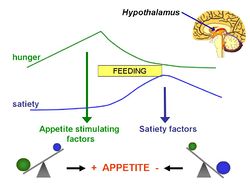Aminostatic hypothesis: Difference between revisions
Jump to navigation
Jump to search

imported>Ashleigh Fraser No edit summary |
imported>Ashleigh Fraser No edit summary |
||
| Line 6: | Line 6: | ||
==References== | ==References== | ||
{{reflist | 2}} | {{reflist | 2}} | ||
''' | '''Experimental Evidence''' | ||
Revision as of 08:36, 25 October 2011
For the course duration, the article is closed to outside editing. Of course you can always leave comments on the discussion page. The anticipated date of course completion is 01 April 2012. One month after that date at the latest, this notice shall be removed. Besides, many other Citizendium articles welcome your collaboration! |
In 1956, Mellinkoff proposed the aminostatic hypothesis, stimulated by the observation that when normal individuals ingest protein, appetite diminishes as the serum amino acid concentration rises and vice versa.[1]
References
- ↑ Mellinkoff SM et al. (1956) Relationship between serum amino acid concentration and fluctuations in appetite J Appl Physiol 8:535-8 PMID 13295170
Experimental Evidence
